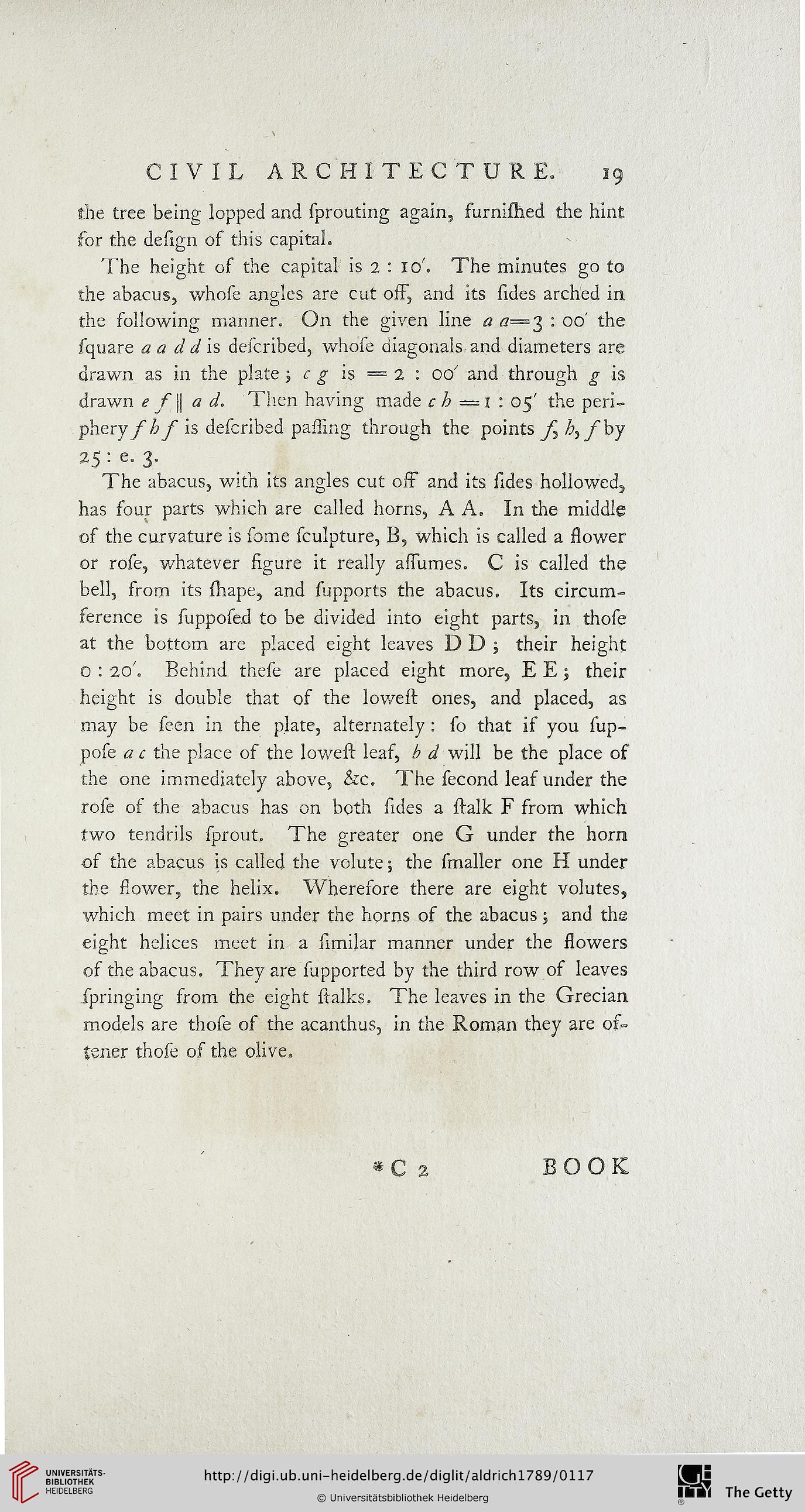CIVIL ARCHITECTURE, 19
the tree being lopped and sprouting again, furnistied the hint
sor the design of this capital.
The height of the capital is 2 : ioh The minutes go to
the abacus, whose angles are cut off, and its Tides arched in
the following manner. On the given line a a= 3 : 00' the
square a a d d is dcscribed, whose diagonals and diameters are
drawn as in the plate ; c g is — 2 : oo7 and through g is
drawn e f || a d. Then having made c h = 1 : 05' the peri-
phery fbf is described palling through the points f h, f by
25: e. 3.
The abacus, with its angles cut off and its Tides hollowed,
has four parts which are called horns, A A. In the middle
of the curvature is some sculpture, B, which is called a ssower
or rose, whatever figure it really assumes. C is called the
bell, from its Ihape, and supports the abacus. Its circum-
serence is supposed to be divided into eight parts, in those
at the bottom are placed eight leaves D D ; their height
o : 20'. Behind these are placed eight more, EE) their
height is double that of the lowest ones, and placed, as
may be seen in the plate, alternately : so that if you sup-
pose a c the place of the lowest leaf, b d will be the place os
the one immediately above, &c. The second leaf under the
rose of the abacus has on both Tides a stalk F from which
two tendrils sprout. The greater one G under the horn
os the abacus is called the volute; the smaller one H under
the flower, the helix. Wheresore there are eight volutes,
which meet in pairs under the horns of the abacus) and the
eight helices meet in a similar manner under the ssowers
of the abacus. They are supported by the third row of leaves
ipringing from the eight stalks. The leaves in the Grecian
models are those of the acanthus, in the Roman they are os-
tener those os the olive.
* C 2
BOOK
the tree being lopped and sprouting again, furnistied the hint
sor the design of this capital.
The height of the capital is 2 : ioh The minutes go to
the abacus, whose angles are cut off, and its Tides arched in
the following manner. On the given line a a= 3 : 00' the
square a a d d is dcscribed, whose diagonals and diameters are
drawn as in the plate ; c g is — 2 : oo7 and through g is
drawn e f || a d. Then having made c h = 1 : 05' the peri-
phery fbf is described palling through the points f h, f by
25: e. 3.
The abacus, with its angles cut off and its Tides hollowed,
has four parts which are called horns, A A. In the middle
of the curvature is some sculpture, B, which is called a ssower
or rose, whatever figure it really assumes. C is called the
bell, from its Ihape, and supports the abacus. Its circum-
serence is supposed to be divided into eight parts, in those
at the bottom are placed eight leaves D D ; their height
o : 20'. Behind these are placed eight more, EE) their
height is double that of the lowest ones, and placed, as
may be seen in the plate, alternately : so that if you sup-
pose a c the place of the lowest leaf, b d will be the place os
the one immediately above, &c. The second leaf under the
rose of the abacus has on both Tides a stalk F from which
two tendrils sprout. The greater one G under the horn
os the abacus is called the volute; the smaller one H under
the flower, the helix. Wheresore there are eight volutes,
which meet in pairs under the horns of the abacus) and the
eight helices meet in a similar manner under the ssowers
of the abacus. They are supported by the third row of leaves
ipringing from the eight stalks. The leaves in the Grecian
models are those of the acanthus, in the Roman they are os-
tener those os the olive.
* C 2
BOOK





